Abstract
Family studies were carried out to look at CR1 expression in 24 hydralazine-induced SLE patients (Hz Reactors), who had been off the drug for at least 1 year and were clinically well at the time of the study. Mean expression of CR1 was reduced by 27% in the group of hypertensives who had developed Hz-induced SLE compared with a group of 35 normal individuals. CR1 expression was also slightly reduced in the relatives of the Hz Reactors compared to the normal group. Using a solid-phase Clq binding assay, CIC levels were found to be elevated in the plasma of the Hz reactors and an inverse relationship was found between CR1 levels and CIC levels in this patient group. Both CR1 levels and CIC levels in Hz Reactors and normal individuals were constant over the 36 weeks studied. This study suggests that there is an association between an inability to deal efficiently with CIC and susceptibility to developing Hz-induced SLE.
Full text
PDF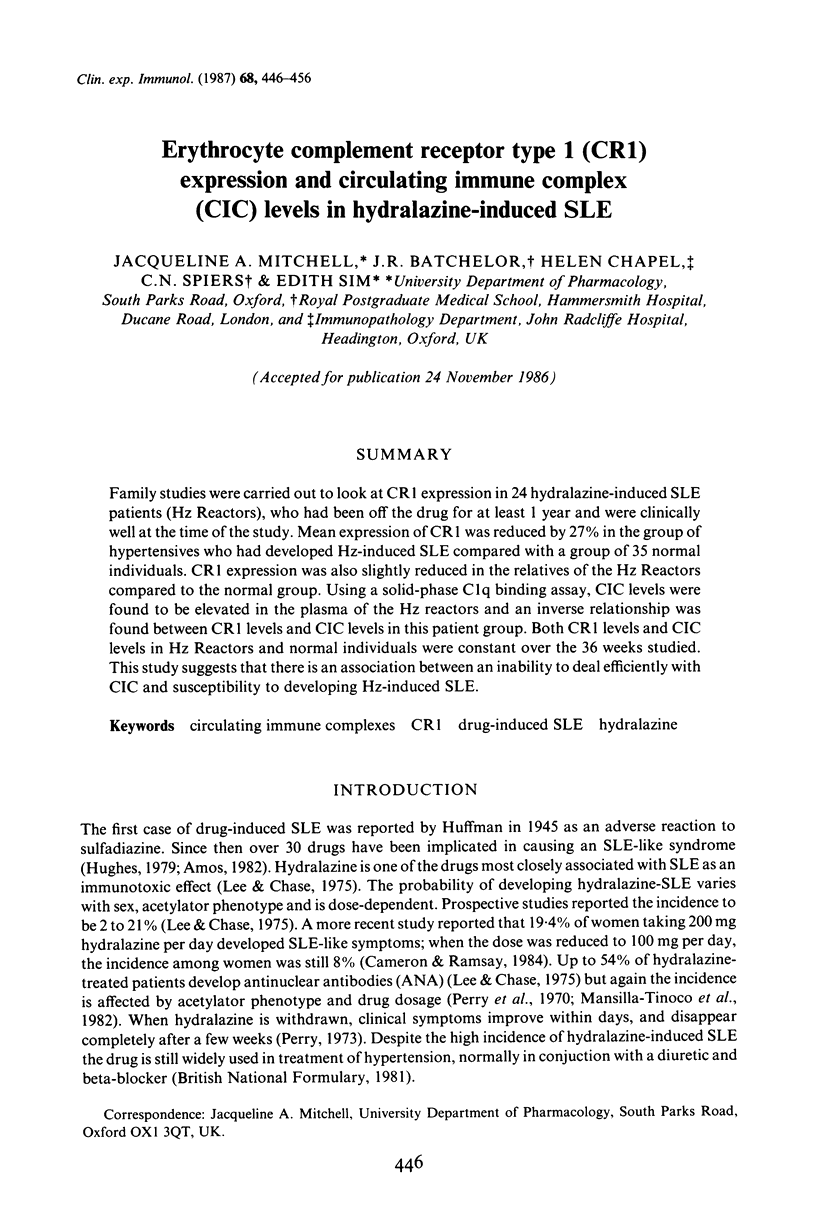
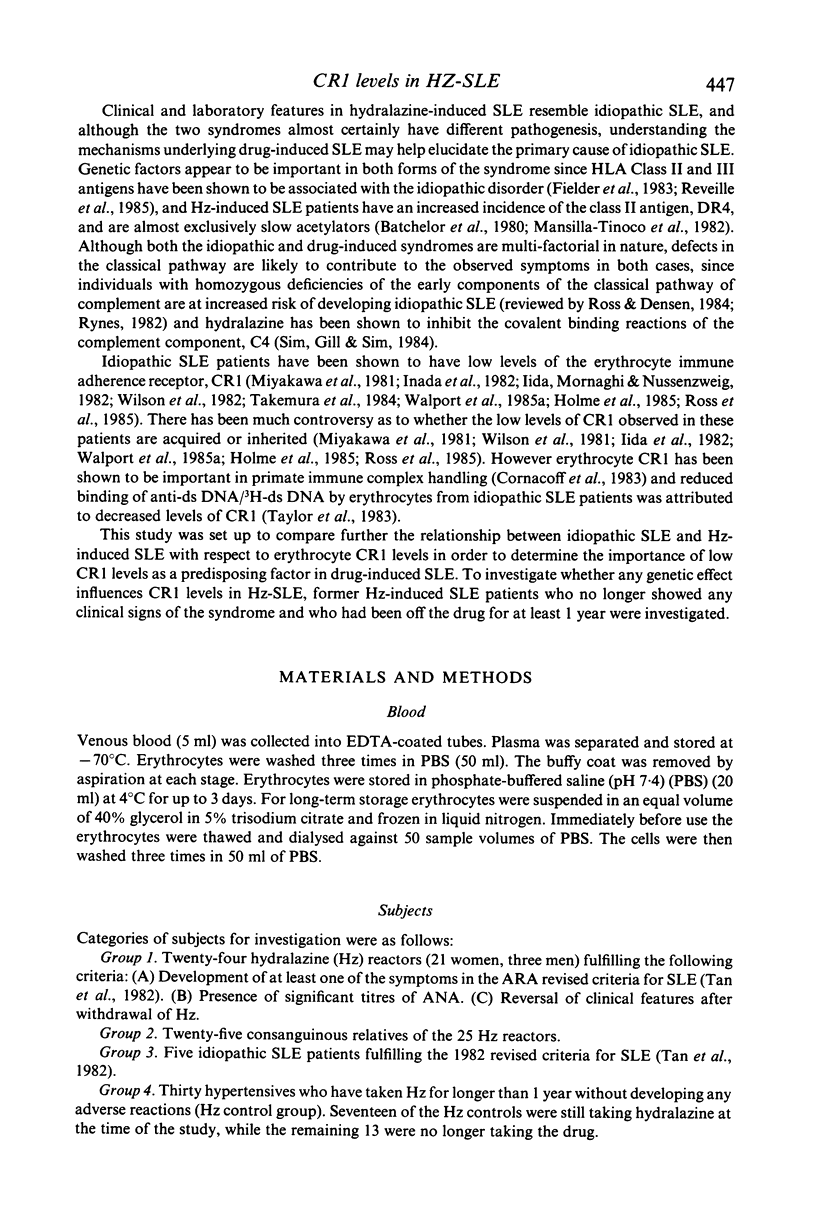
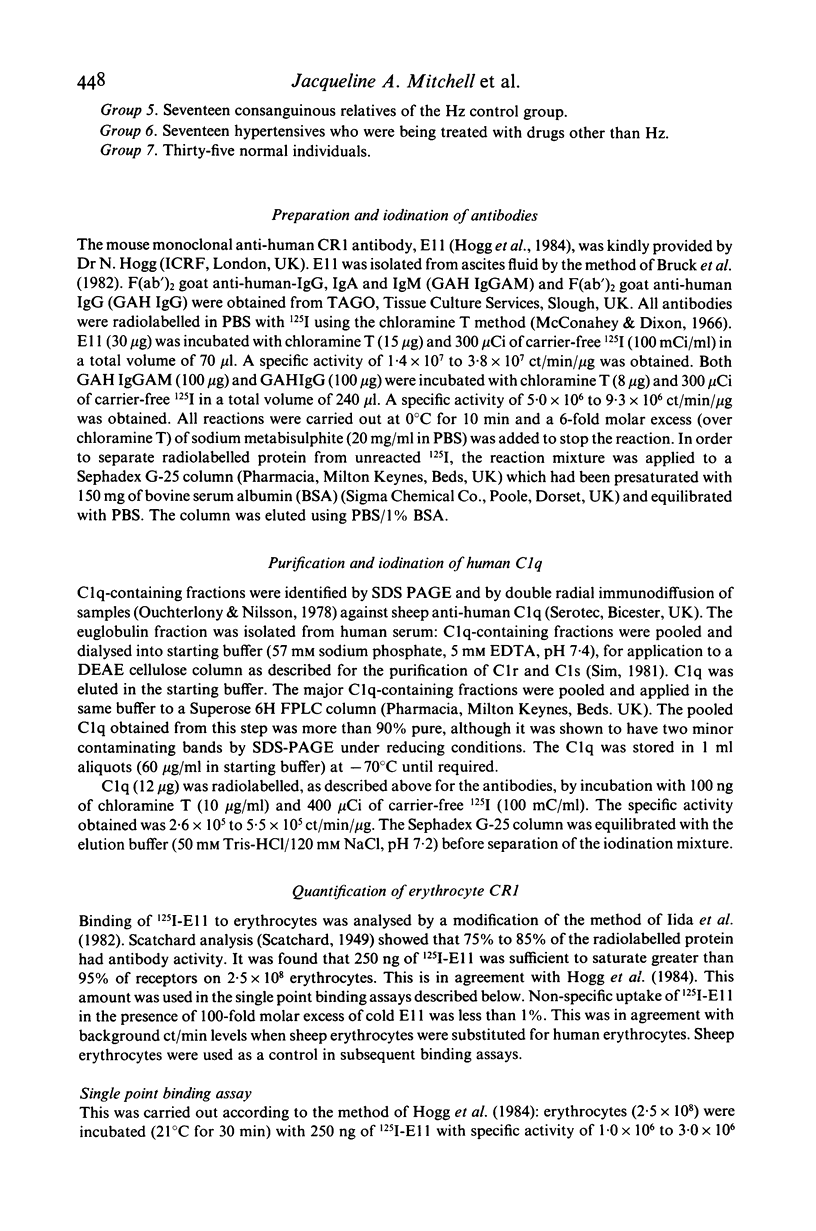
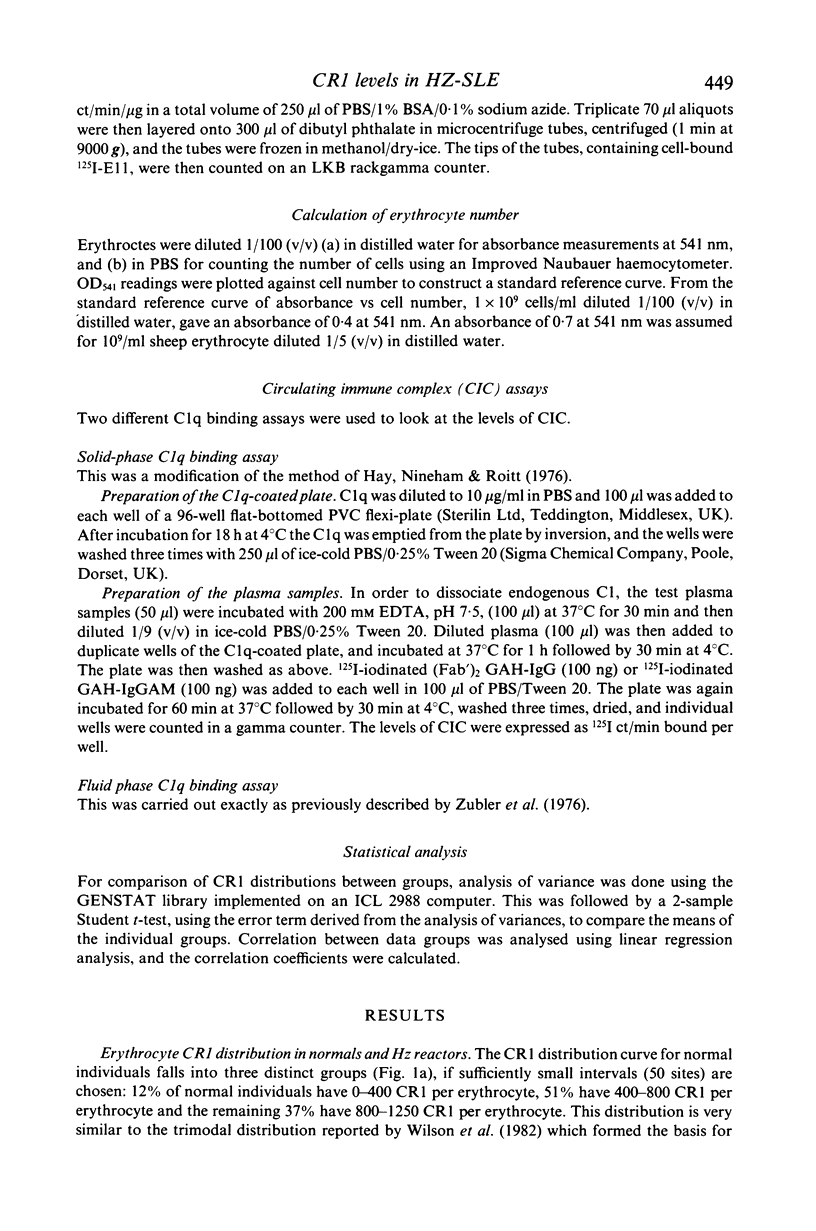
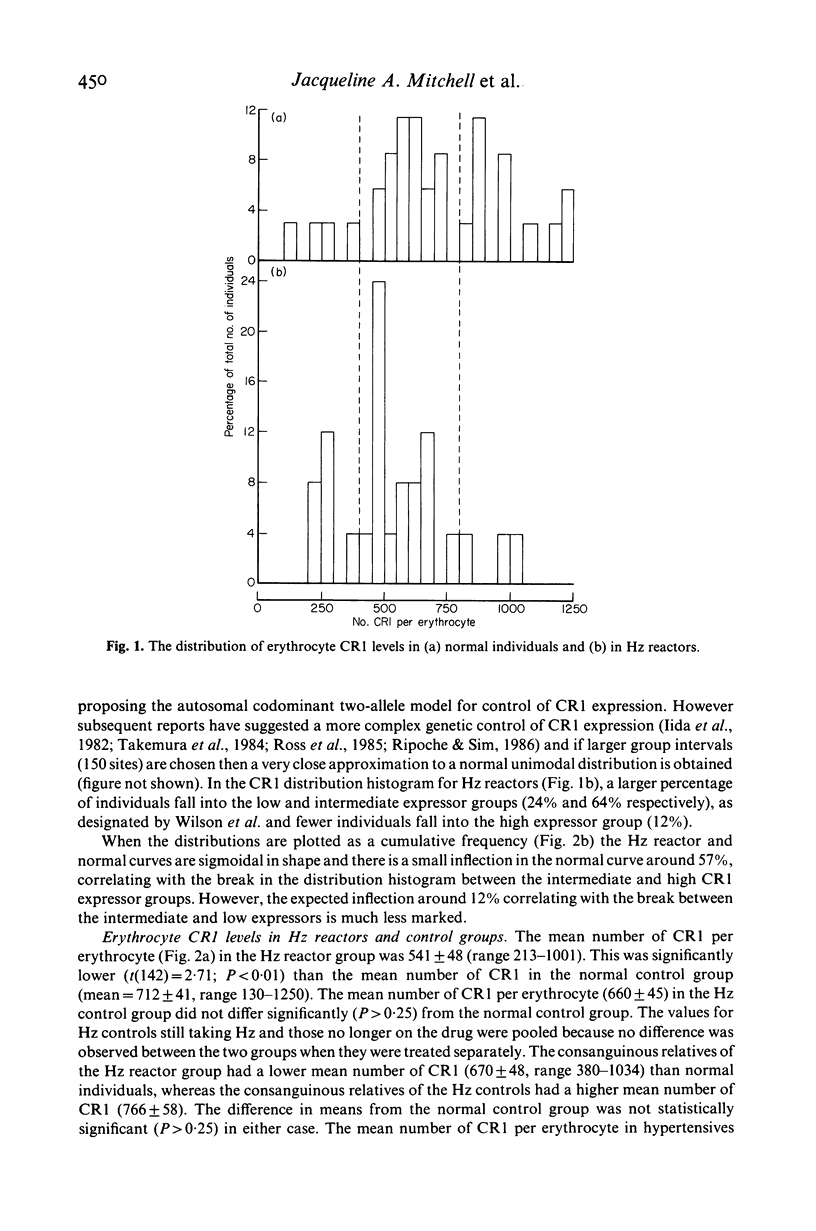
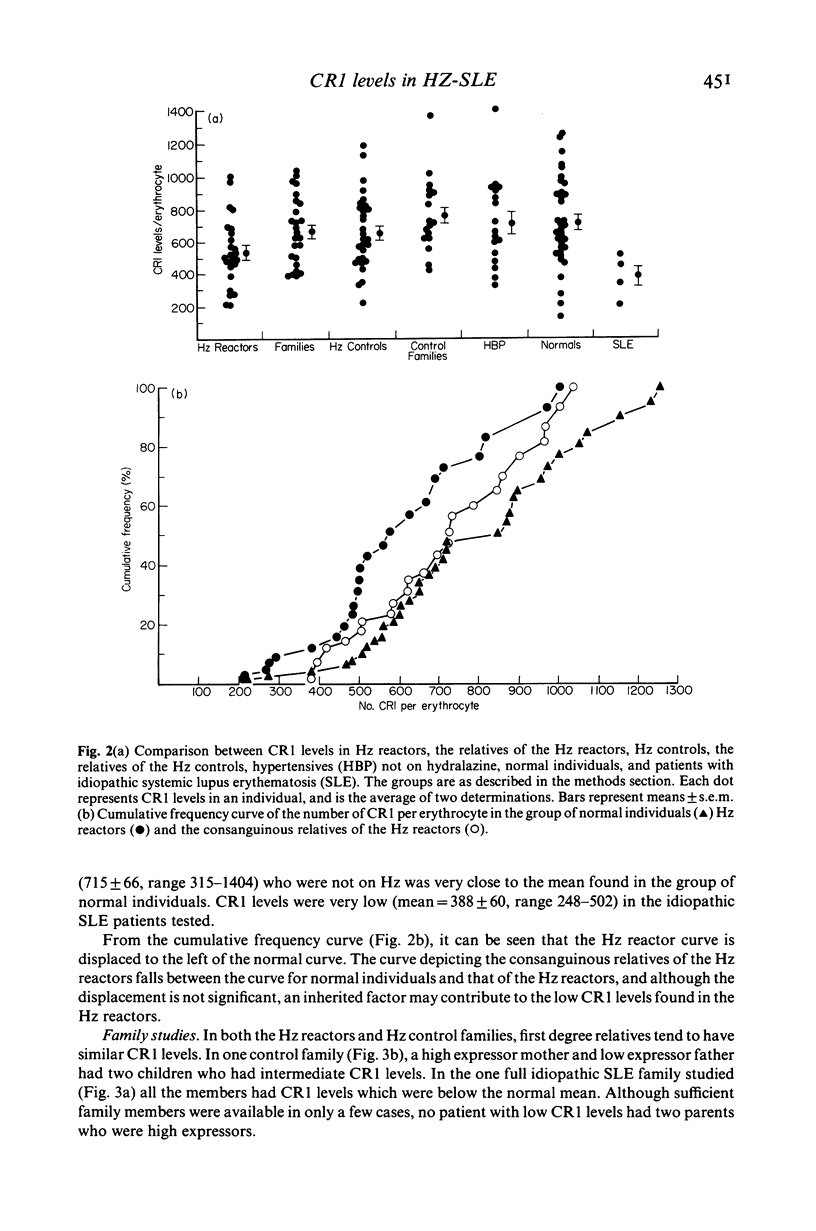
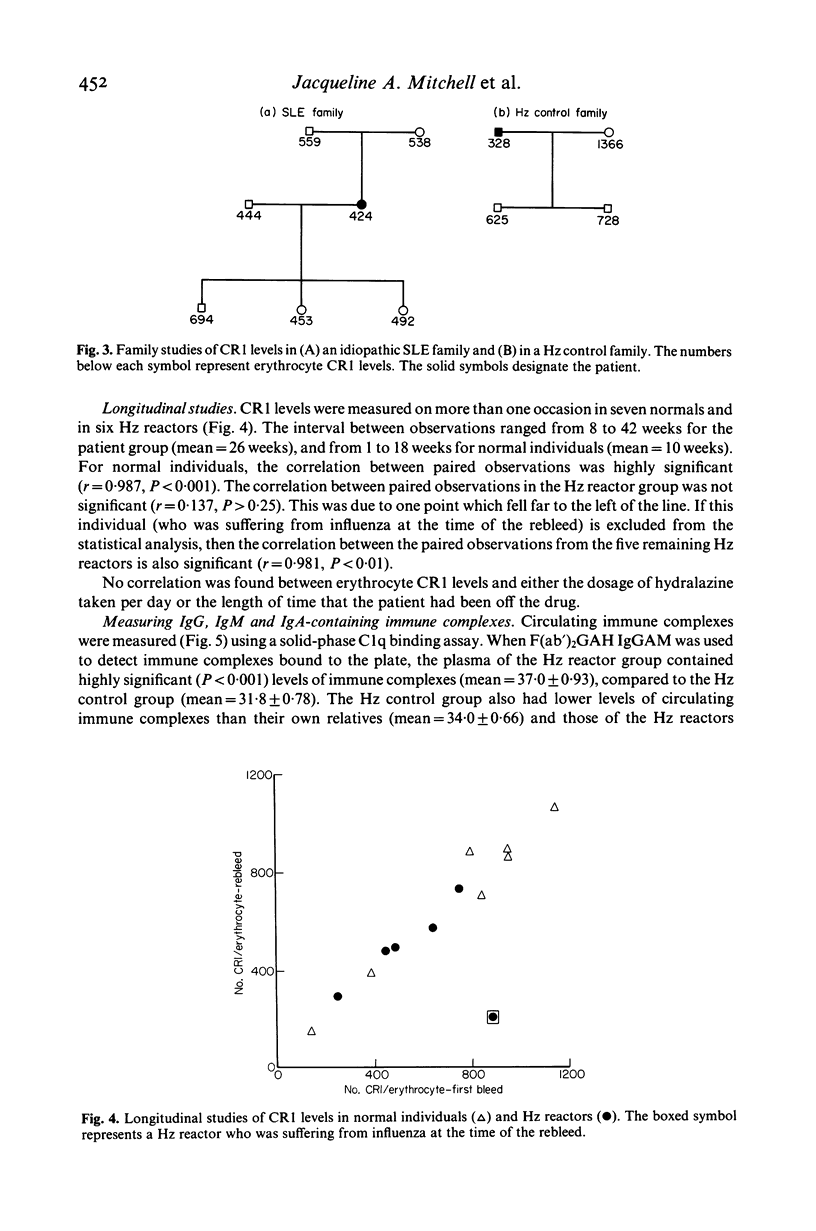

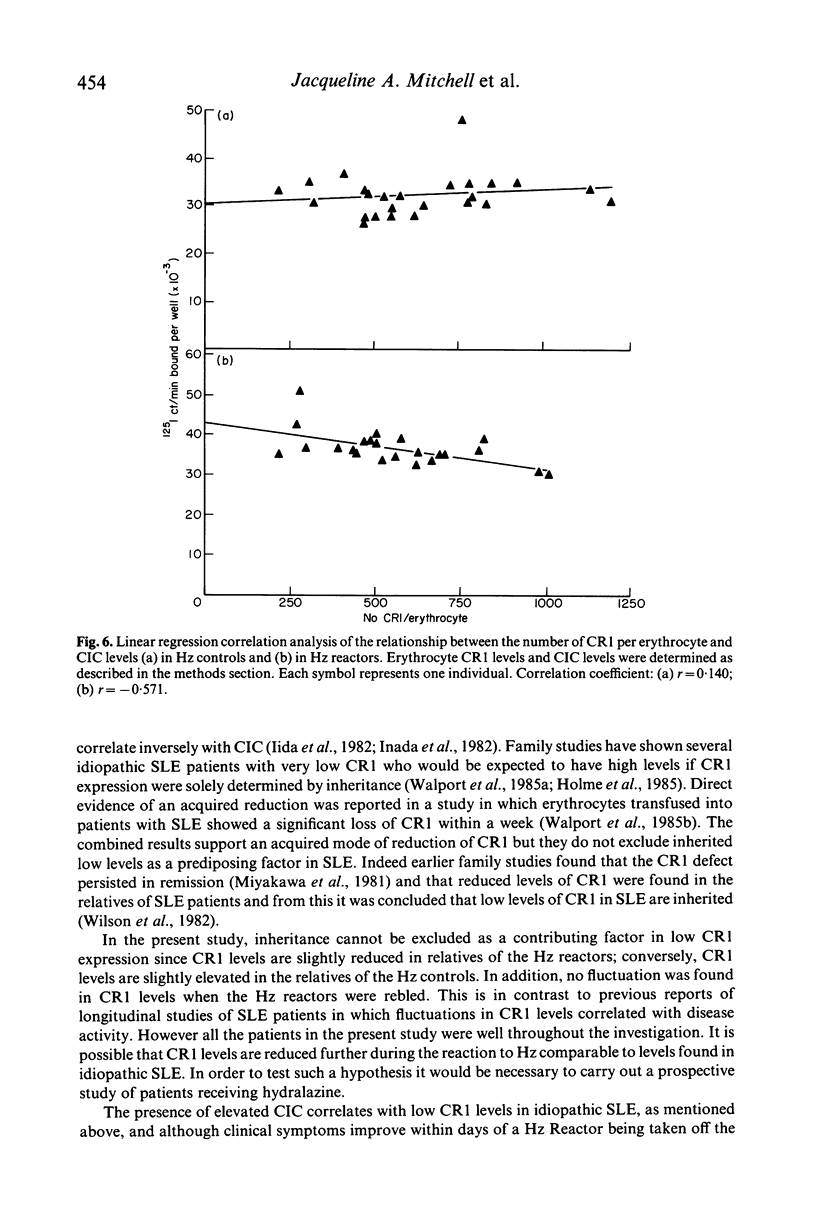

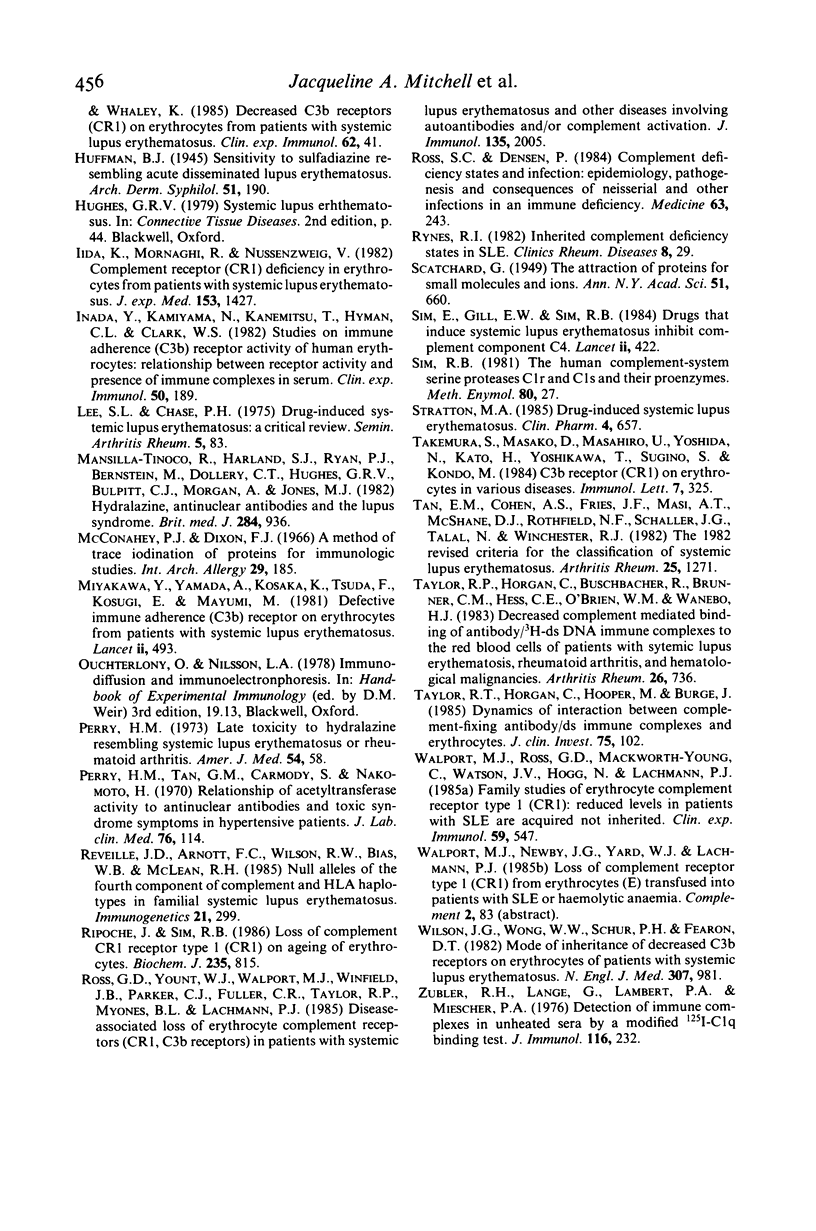
Selected References
These references are in PubMed. This may not be the complete list of references from this article.
- Batchelor J. R., Welsh K. I., Tinoco R. M., Dollery C. T., Hughes G. R., Bernstein R., Ryan P., Naish P. F., Aber G. M., Bing R. F. Hydralazine-induced systemic lupus erythematosus: influence of HLA-DR and sex on susceptibility. Lancet. 1980 May 24;1(8178):1107–1109. doi: 10.1016/s0140-6736(80)91554-8. [DOI] [PubMed] [Google Scholar]
- Bruck C., Portetelle D., Glineur C., Bollen A. One-step purification of mouse monoclonal antibodies from ascitic fluid by DEAE Affi-Gel blue chromatography. J Immunol Methods. 1982 Sep 30;53(3):313–319. doi: 10.1016/0022-1759(82)90178-8. [DOI] [PubMed] [Google Scholar]
- Cameron H. A., Ramsay L. E. The lupus syndrome induced by hydralazine: a common complication with low dose treatment. Br Med J (Clin Res Ed) 1984 Aug 18;289(6442):410–412. doi: 10.1136/bmj.289.6442.410. [DOI] [PMC free article] [PubMed] [Google Scholar]
- Cornacoff J. B., Hebert L. A., Smead W. L., VanAman M. E., Birmingham D. J., Waxman F. J. Primate erythrocyte-immune complex-clearing mechanism. J Clin Invest. 1983 Feb;71(2):236–247. doi: 10.1172/JCI110764. [DOI] [PMC free article] [PubMed] [Google Scholar]
- Fielder A. H., Walport M. J., Batchelor J. R., Rynes R. I., Black C. M., Dodi I. A., Hughes G. R. Family study of the major histocompatibility complex in patients with systemic lupus erythematosus: importance of null alleles of C4A and C4B in determining disease susceptibility. Br Med J (Clin Res Ed) 1983 Feb 5;286(6363):425–428. doi: 10.1136/bmj.286.6363.425. [DOI] [PMC free article] [PubMed] [Google Scholar]
- Hay F. C., Nineham L. J., Roitt I. M. Routine assay for the detection of immune complexes of known immunoglobulin class using solid phase C1q. Clin Exp Immunol. 1976 Jun;24(3):396–400. [PMC free article] [PubMed] [Google Scholar]
- Hogg N., Ross G. D., Jones D. B., Slusarenko M., Walport M. J., Lachmann P. J. Identification of an anti-monocyte monoclonal antibody that is specific for membrane complement receptor type one (CR1). Eur J Immunol. 1984 Mar;14(3):236–243. doi: 10.1002/eji.1830140307. [DOI] [PubMed] [Google Scholar]
- Iida K., Mornaghi R., Nussenzweig V. Complement receptor (CR1) deficiency in erythrocytes from patients with systemic lupus erythematosus. J Exp Med. 1982 May 1;155(5):1427–1438. doi: 10.1084/jem.155.5.1427. [DOI] [PMC free article] [PubMed] [Google Scholar]
- Inada Y., Kamiyama M., Kanemitsu T., Hyman C. L., Clark W. S. Studies on immune adherence (C3b) receptor activity of human erythrocytes: relationship between receptor activity and presence of immune complexes in serum. Clin Exp Immunol. 1982 Oct;50(1):189–197. [PMC free article] [PubMed] [Google Scholar]
- Lee S. L., CHase P. H. Drug-induced systemic lupus erythematosus: a critical review. Semin Arthritis Rheum. 1975 Aug;5(1):83–103. doi: 10.1016/0049-0172(75)90024-4. [DOI] [PubMed] [Google Scholar]
- Mansilla-Tinoco R., Harland S. J., Ryan P. J., Bernstein R. M., Dollery C. T., Hughes G. R., Bulpitt C. J., Morgan A., Jones J. M. Hydralazine, antinuclear antibodies, and the lupus syndrome. Br Med J (Clin Res Ed) 1982 Mar 27;284(6320):936–939. doi: 10.1136/bmj.284.6320.936. [DOI] [PMC free article] [PubMed] [Google Scholar]
- McConahey P. J., Dixon F. J. A method of trace iodination of proteins for immunologic studies. Int Arch Allergy Appl Immunol. 1966;29(2):185–189. doi: 10.1159/000229699. [DOI] [PubMed] [Google Scholar]
- Miyakawa Y., Yamada A., Kosaka K., Tsuda F., Kosugi E., Mayumi M. Defective immune-adherence (C3b) receptor on erythrocytes from patients with systemic lupus erythematosus. Lancet. 1981 Sep 5;2(8245):493–497. doi: 10.1016/s0140-6736(81)90882-5. [DOI] [PubMed] [Google Scholar]
- Perry H. M., Jr Late toxicity to hydralazine resembling systemic lupus erythematosus or rheumatoid arthritis. Am J Med. 1973 Jan;54(1):58–72. doi: 10.1016/0002-9343(73)90084-3. [DOI] [PubMed] [Google Scholar]
- Perry H. M., Jr, Tan E. M., Carmody S., Sakamoto A. Relationship of acetyl transferase activity to antinuclear antibodies and toxic symptoms in hypertensive patients treated with hydralazine. J Lab Clin Med. 1970 Jul;76(1):114–125. [PubMed] [Google Scholar]
- Reveille J. D., Arnett F. C., Wilson R. W., Bias W. B., McLean R. H. Null alleles of the fourth component of complement and HLA haplotypes in familial systemic lupus erythematosus. Immunogenetics. 1985;21(4):299–311. doi: 10.1007/BF00430796. [DOI] [PubMed] [Google Scholar]
- Ripoche J., Sim R. B. Loss of complement receptor type 1 (CR1) on ageing of erythrocytes. Studies of proteolytic release of the receptor. Biochem J. 1986 May 1;235(3):815–821. doi: 10.1042/bj2350815. [DOI] [PMC free article] [PubMed] [Google Scholar]
- Ross G. D., Yount W. J., Walport M. J., Winfield J. B., Parker C. J., Fuller C. R., Taylor R. P., Myones B. L., Lachmann P. J. Disease-associated loss of erythrocyte complement receptors (CR1, C3b receptors) in patients with systemic lupus erythematosus and other diseases involving autoantibodies and/or complement activation. J Immunol. 1985 Sep;135(3):2005–2014. [PubMed] [Google Scholar]
- Ross S. C., Densen P. Complement deficiency states and infection: epidemiology, pathogenesis and consequences of neisserial and other infections in an immune deficiency. Medicine (Baltimore) 1984 Sep;63(5):243–273. [PubMed] [Google Scholar]
- Rynes R. I. Inherited complement deficiency states and SLE. Clin Rheum Dis. 1982 Apr;8(1):29–47. [PubMed] [Google Scholar]
- Sim E., Gill E. W., Sim R. B. Drugs that induce systemic lupus erythematosus inhibit complement component C4. Lancet. 1984 Aug 25;2(8400):422–424. doi: 10.1016/s0140-6736(84)92905-2. [DOI] [PubMed] [Google Scholar]
- Stratton M. A. Drug-induced systemic lupus erythematosus. Clin Pharm. 1985 Nov-Dec;4(6):657–663. [PubMed] [Google Scholar]
- Takemura S., Deguchi M., Ueda M., Yoshida N., Kato H., Yoshikawa T., Sugino S., Kondo M. C3b receptor (CR1) on erythrocytes in various diseases. Immunol Lett. 1984;7(6):325–328. doi: 10.1016/0165-2478(84)90089-0. [DOI] [PubMed] [Google Scholar]
- Tan E. M., Cohen A. S., Fries J. F., Masi A. T., McShane D. J., Rothfield N. F., Schaller J. G., Talal N., Winchester R. J. The 1982 revised criteria for the classification of systemic lupus erythematosus. Arthritis Rheum. 1982 Nov;25(11):1271–1277. doi: 10.1002/art.1780251101. [DOI] [PubMed] [Google Scholar]
- Taylor R. P., Horgan C., Buschbacher R., Brunner C. M., Hess C. E., O'Brien W. M., Wanebo H. J. Decreased complement mediated binding of antibody/3H-dsDNA immune complexes to the red blood cells of patients with systemic lupus erythematosus, rheumatoid arthritis, and hematologic malignancies. Arthritis Rheum. 1983 Jun;26(6):736–744. doi: 10.1002/art.1780260606. [DOI] [PubMed] [Google Scholar]
- Taylor R. P., Horgan C., Hooper M., Burge J. Dynamics of interaction between complement-fixing antibody/dsDNA immune complexes and erythrocytes. In vitro studies and potential general applications to clinical immune complex testing. J Clin Invest. 1985 Jan;75(1):102–111. doi: 10.1172/JCI111660. [DOI] [PMC free article] [PubMed] [Google Scholar]
- Walport M. J., Ross G. D., Mackworth-Young C., Watson J. V., Hogg N., Lachmann P. J. Family studies of erythrocyte complement receptor type 1 levels: reduced levels in patients with SLE are acquired, not inherited. Clin Exp Immunol. 1985 Mar;59(3):547–554. [PMC free article] [PubMed] [Google Scholar]
- Wilson J. G., Wong W. W., Schur P. H., Fearon D. T. Mode of inheritance of decreased C3b receptors on erythrocytes of patients with systemic lupus erythematosus. N Engl J Med. 1982 Oct 14;307(16):981–986. doi: 10.1056/NEJM198210143071604. [DOI] [PubMed] [Google Scholar]
- Zubler R. H., Lange G., Lambert P. H., Miescher P. A. Detection of immune complexes in unheated sera by modified 125I-Clq binding test. Effect of heating on the binding of Clq by immune complexes and application of the test to systemic lupus erythematosus. J Immunol. 1976 Jan;116(1):232–235. [PubMed] [Google Scholar]


